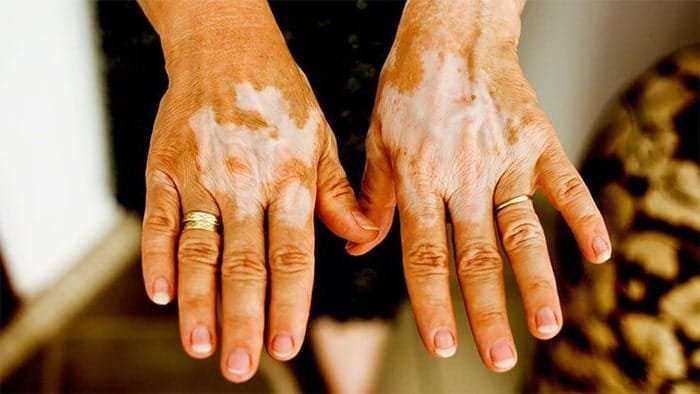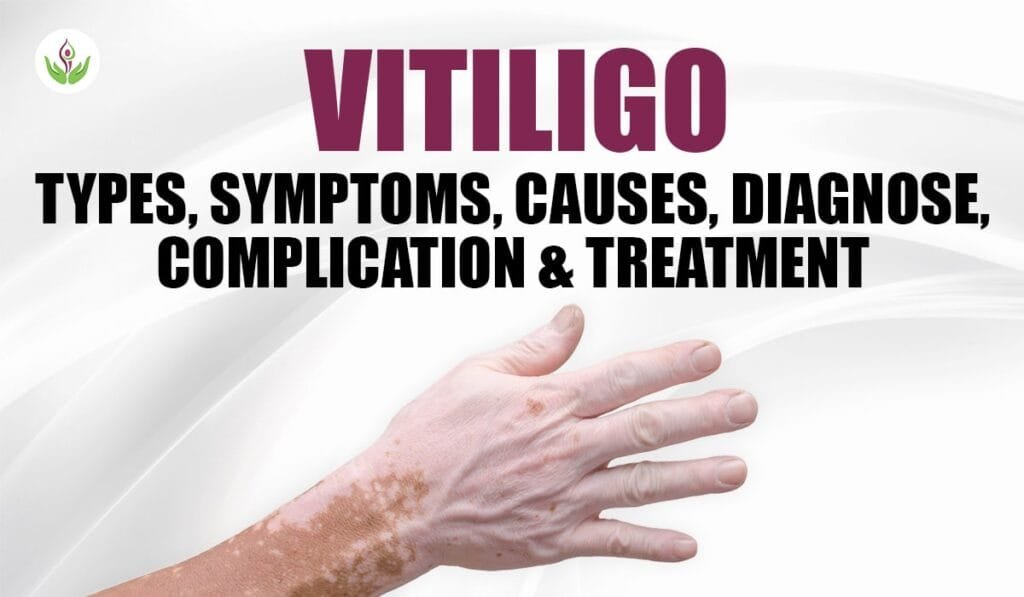Overview
Vitiligo is a disease that leads to loss of skin color in patches. With time, the discolored areas often get bigger. It is important to know this condition can affect any skin area of your body.
It can even affect hair as well as the inside of your mouth. This mainly happens due to the lack of melanin which is one of the pigments in the skin.
Remember vitiligo can affect any area of your skin but it generally happens on the hands, face, and neck as well as in skin creases.
You must know that the pale area of your skin is more exposed to sunburn. Due to this reason, you must always take extra care when in the sun and make use of quality sunscreen to offer high sun protection.
Although vitiligo affects people of all skin types it is quite common in people with dark skin tones. However, effective treatment of vitiligo can aid in restoring the color of your affected skin.
Though the condition is not itchy or painful, the visibility of white patches can make you feel self-conscious particularly, if vitiligo affects the skin in visible areas like the legs, face, or arms.
Types of Vitiligo
When it comes to vitiligo, there are mainly two types:
- Non-segmental vitiligo
- Segmental vitiligo
In very rare cases, vitiligo affects the entire body. This is called complete or universal vitiligo.
Non-segmental Vitiligo

Non-segmental vitiligo is also called generalized or bilateral vitiligo. The symptoms of this type of vitiligo are seen on both sides of your body in symmetrical white patches.
It is important to know that symmetrical patches can appear on the:
- Arms
- Elbows
- Back of your hands
- Feet
- Knees
- Elbows
Non-segmental vitiligo is considered one of the most common types of vitiligo because almost 9 in 10 people are affected by this condition.
Segmental Vitiligo

Segmental vitiligo also known as unilateral or localized vitiligo is the condition in which you suffer from white patches in just one area of your body. This type of vitiligo is not common when compared to non-segmental vitiligo. It can be found in children and affects at least 3 in 10 children.
Vitiligo Symptoms
The areas of skin affected by vitiligo generally include:
- Mouth and eyes
- Armpits
- Inside your mouth
- Fingers and wrists
- Genitals
- Groin
Sometimes, you can even find vitiligo in your hair roots like on your scalp. The lack of melanin in your skin can even turn the hair in the affected region white or grey.
You must know that vitiligo mainly begins as a pale patch of skin but slowly turns white completely. The centre of the patch might be white with paler skin around it. If there are blood vessels under your skin, the patch can also look pink, instead of white.
The edges of the patch can be irregular or smooth. Sometimes, they can even look inflamed and red or there can be brownish discoloration (known as hyperpigmentation).
Short Summary
Though vitiligo is not going to cause discomfort to your skin like dryness the patches can be itchy sometimes. However, the condition differs from person to person. Some people only get a few small white patches but others suffer from big white patches that join large areas of their skin.
Vitiligo Causes
There are several causes behind vitiligo but some of the common causes include:
- Autoimmune disorder
- Genetic factors
- Neurogenic factors
Vitiligo is caused due to the lack of a pigment known as melanin in your skin. Keep one thing in your mind, melanin is produced by your skin cells known as melanocytes, giving your skin its color.
When you suffer from vitiligo, there are not enough working melanocytes for producing melanin in your skin. As a result, white patches develop on your skin or hair. Though, it is yet not clear why the melanocytes disappear from the affected areas of your skin.
Autoimmune conditions
Non-segmental vitiligo is considered an autoimmune condition. It is a condition in which your immune system does not function properly. Instead of attacking your body’s foreign cells like viruses, your immune system starts to attack the healthy cells and tissue of your body.
In case you have non-segmental vitiligo, your immune system destroys the melanocyte skin cells that are responsible for making melanin.
Neurochemicals
Segmental vitiligo is caused due to the chemicals that are released from the nerve endings of your skin. These chemicals are deadly to the melanocyte skin cells.
Vitiligo Diagnose
Dermatologists often diagnose vitiligo with the help of a physical examination. In order to get more information about the condition and how it is affecting your skin cells, the doctor will recommend you a blood test or skin biopsy.
Medical history
In the medical history, the dermatologist will collect all the information about your past and current health so that the diagnosis can be confirmed. Your medical history will be asked about when white or light patches of skin first appear and whether they affect different parts of the body or remain in just one area.
In case, you have an autoimmune disorder like type 1 diabetes or hypothyroidism or any family member has a history of vitiligo, the doctor might ask for medical history in that condition also.
Physical examination
To determine whether vitiligo is affecting your skin and if yes, then to know the type, your dermatologist will perform a proper physical examination. He or she will also examine your skin visually right from head to toe in order to check where depigmentation is present.
The doctor will also check whether the patches appear on just one side of your body or both sides. It will also determine whether your skin is affected only when exposed to sunlight or whether the areas that are less exposed also get affected equally.
However, vitiligo is very difficult to distinguish if you have a fair skin tone. In this condition, the doctor makes use of a handheld tool known as a wood lamp to shine UV light on the skin.
Under UV light, a patch of skin that is depigmented is visible easily.
Skin Biopsy
To successfully validate a diagnosis of vitiligo, your dermatologist can require more information about the skin cells. A skin biopsy helps in telling the difference between missing melanocytes that are responsible for showing vitiligo and also melanocytes that are not functioning properly.
Keep one thing in your mind, vitiligo is detected only when the pigment-producing cells miss.
Blood test
Dermatologists rarely suggest blood tests. Through this test, it is easy to attain more information about a potential autoimmune response that is linked to vitiligo.
Once the blood test is done, you will get the results in five to seven days.
Vitiligo Complications
People who suffer from vitiligo often have an increased risk of:
- Hearing loss
- Social or psychological distress
- Eye problems
- Sunburn
Vitiligo Treatment
When vitiligo turns serious, it is important to consider an effective treatment. The white patches caused by vitiligo are permanent but with the right treatment, it is easy to decrease their appearance.
In case, the patches are small then you can make use of skin camouflage to cover them up. Steroid creams are also helpful in restoring your skin pigmentation. Remember long-term usage of steroid creams can lead to stretch marks and thinning of your skin.
If you find steroid cream is not working in treating vitiligo then you can also choose phototherapy treatment. Though treatment can restore the color of your skin this effect is not going to last for a long time. Before choosing any treatment option, you must always consult your dermatologist once.
Read More: Penile Vitiligo Can Be Treated – See How?
Vitiligo Diet
Although there is no prescribed vitiligo diet, following nutritional steps includes eating a healthy diet filled with important nutrients and drinking plenty of water.
In case, the reason behind your vitiligo is an autoimmune disorder then you can attain great benefits from immune system-boosting foods that include beta-carotene, antioxidants as well as phytochemicals.
People suffering from a vitiligo skin disorder must include the below-stated food items in their diet:
- Bananas
- Leafy greens like romaine lettuce
- Apples
- Figs and dates
- Chickpeas
- Root vegetables like radishes, beets, and carrots
Diet restrictions
Just like there is no suggested diet to treat vitiligo there are also no medically recognized foods that can worsen your condition. But it is better to avoid the consumption of some foods that contain depigmenting agents like hydroquinones.
Everyone’s body reacts differently to some food items. When suffering from vitiligo, it is better to avoid the below-stated food items:
- Blueberries
- Coffee
- Alcohol
- Fruit juice
- Fish
- Tomatoes
- Grapes
- Pickles
- Wheat products
Home Remedies
People suffering from vitiligo often lack healthy levels of certain nutrients in their bodies. It is vital to know that no evidence is there that consumption of certain food items can decline or improve your condition of vitiligo.
But some home remedies are helping people to deal with vitiligo successfully and can be tried easily. Some prevalent home remedies include:
- A mixture of lemon and sweet basil extract
- A mixture of turmeric as well as mustard oil
- Ginkgo biloba paste
Short Summary
In short, it can be concluded that vitiligo is a common skin disorder that can be treated with the right medications and home medications under the supervision of an experienced dermatologist.
Here are some questions that might come to your mind if you are suffering from vitiligo:
How does vitiligo progress?
Vitiligo mainly starts from a few small white patches and can spread throughout your body with time. It usually starts from the hands, feet, forearms, and face but can develop on any part of your body Large patches continue to widen and spread but remain in the same place for years.
Is vitiligo painful?
Though it is not painful, you might suffer from painful sunburns on the lighter patches of your skin.
Can you inherit vitiligo?
It is not important that you will inherit vitiligo. But it is noticed that almost 30% of people who suffer from vitiligo often have one close relative who already has the problem of vitiligo.










